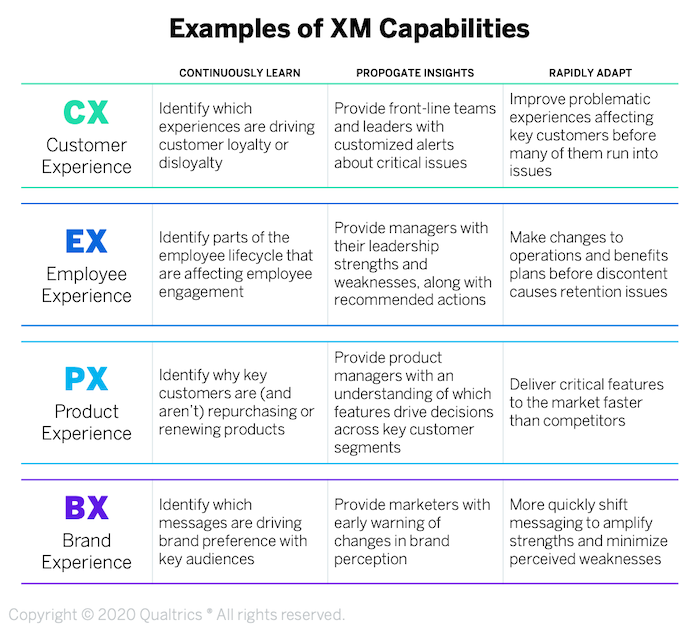What is Experience Management (XM)?
What is Experience Management (XM)?
To create and enhance the experiences you offer, it is important to listen to the opinions of consumers, workers, and other stakeholders. This may be done comprehensively through the practice of Experience Management (XM). Businesses use it to create new experiences for their customers and employees based on insightful market research that reveals unfulfilled needs. They can then tweak and improve these experiences over time to meet the evolving demands of their market and stakeholders.
The goal of Experience Management is to create positive and memorable experiences for customers, employees, partners, and other stakeholders, ultimately leading to increased loyalty, satisfaction, and advocacy. By consistently delivering exceptional experiences, organizations can differentiate themselves from competitors and drive long-term success.
This image has been taken from the Qualtrics website.
Implement software designed for experience management
Companies can save time and get more accurate results by digitizing experience management rather than gathering and analyzing data manually. Using sentiment analysis and the ability to monitor interactions across several channels, brand experience management software can pinpoint possible flaws and evaluate consumer and employee attitudes.
Read this latest post on customer experience
Make a map of your Journey
You may be familiar with customer journey maps, which show the whole customer lifecycle, from discovery of your business to post-purchase review, and everything in between. You can optimize each step of the customer’s journey by understanding its full breadth with the help of these journey maps. If you find that half of your consumers leave during your company’s discovery phase, you can work on making lead generation more engaging by, for instance, redesigning your landing pages or sending out more engaging emails.
Make use of social listening techniques
To find out what people are saying about your business on social media, you should practice social listening. Social listening is a great way to get feedback that doesn’t come straight from customers, since people often share their experiences with companies on social media, whether good or bad.
Examine, evaluate, and improve
Management of experience is an ongoing endeavor. In reality, it’s an ongoing process that stays with a business forever, letting it adapt to the changing demands of its customers and workers. Because it adapts to your business as it learns, finding the correct experience management tool is crucial. However, it’s as important to have efficient processes and teams to respond quickly to new requirements.
What are the Benefits of XM?
- Synthesize solicited and u********** brand feedback
- Customization
- Evaluate overall brand health
- Detect customer service weaknesses
- Identify how customer sentiment changes over time
- Provide automated and quick follow-up
- Interpret nuance in conversation to offer a more realistic sentiment analysis
- Operational Efficiency
- Reduced Churn and Negative Reviews
- Enhanced Customer Insights
- Increased Revenue
- Customer Satisfaction and Loyalty
Read: Qualtrics Launches Three New AI-Powered Suites for CX, EX, and Research
What is Exciting About the X4 Experience Management Summit?
3 days, 100 sessions, 10K attendees, 10 keynotes, and much more…
At X4 2024, thought leaders and practitioners from the world’s most beloved brands will walk you through everything from cutting-edge program design to the latest strategies for connecting with customers and optimizing omnichannel journeys.
How Does Qualtrics Help Customers Harness the Full Power of AI in Experience Management?

With the help of Qualtrics AI, managers can gain a thorough understanding of team input, which in turn leads to more targeted insights and recommendations for how to improve team performance. Without having to wait for the next survey findings, managers may monitor the immediate effects of their activities on their workforce. A lot of people love using Qualtrics since it has so many different item categories. It’s great because you can ask fun and useful questions at the same time. Users can also stay organized and reach out to specific persons who haven’t finished the survey by using the reminders tool.
- Giving a more perceptive audience to customers
- XM for Customers
- Unlocking the full potential of an empowered customer frontline
- Rethinking the purpose and practice of feedback in the AI era
- The technologies and challenges revolutionizing CX
- What’s the source code for CX success?
- Supercharging CX with Predicted NPS and GenAI
- How AI and predictive listening will re-humanize customer insight and save CX
- What’s the future of customer experience?
- The power of why – Elevating the CX conversation from metrics to measurable outcomes
Why Do Researchers Use Qualtrics?
- If you’re new to qualitative research and looking for an integrated solution, go no further than the Qualtrics XM system.
- It may assist all of your internal teams in creating surveys, collecting data, analyzing text, and reporting data so that they can acquire insights from subjective and categorical data.
- From customer feedback data to product idea analysis, CoreXM gives you a unified platform for data gathering and analysis across your whole business.
- Custom programming in Qualtrics gives you complete control over many aspects, including question types, survey design, embedded data, and more.
- No data is ever transmitted by Qualtrics without first undergoing Transport Layer Security (TLS) encryption, which is also known as HTTPS.
- Passwords can be used to secure surveys. Dependable data centers that have passed independent audits utilizing the SSAE-18 standard are hosting our services.
- Text iQ, one of the qualitative research analysis tools offered by Qualtrics, may help you find trends and patterns in text with the use of strong machine learning and native language processing.
FAQ’s
- What are the key components of Experience Management? The key components of XM include understanding the needs and expectations of stakeholders, measuring experiences through feedback and data, analyzing insights, taking action to improve experiences, and continuously iterating and optimizing.
- What are some common methods for measuring experiences? Common methods for measuring experiences include surveys, interviews, focus groups, customer feedback tools, sentiment analysis, Net Promoter Score (NPS), Customer Satisfaction (CSAT), and Employee Satisfaction (ESAT) surveys.
- How does Experience Management differ from Customer Experience (CX) or Employee Experience (EX)? Experience Management (XM) encompasses both Customer Experience (CX) and Employee Experience (EX), along with other stakeholder experiences. CX focuses on the experiences of customers, while EX focuses on the experiences of employees.
- What are some benefits of implementing Experience Management in an organization? Benefits of XM include increased customer satisfaction and loyalty, higher employee engagement and retention, improved product and service quality, better decision-making based on insights, and competitive advantage.
- How can organizations collect feedback to improve experiences? Organizations can collect feedback through various channels, including surveys, social media monitoring, online reviews, suggestion boxes, focus groups, and direct interactions with customers and employees.
- How can organizations use Experience Management to drive innovation? By listening to customer and employee feedback, identifying pain points and unmet needs, and experimenting with new ideas and solutions, organizations can innovate and differentiate themselves in the market.
- What role does leadership play in fostering a culture of Experience Management? Leadership plays a critical role in setting the vision, values, and priorities for XM, allocating resources, empowering employees, leading by example, and championing the importance of delivering exceptional experiences at every level of the organization.
- How can organizations ensure that they are delivering consistent experiences across different touchpoints? Organizations can ensure consistency by mapping the customer journey or employee journey, identifying key touchpoints, standardizing processes and interactions, training employees, and using technology to monitor and enforce standards.
- What are some common challenges faced when implementing Experience Management initiatives? Common challenges include siloed data and departments, resistance to change, lack of leadership buy-in, difficulty measuring ROI, managing large volumes of feedback, and maintaining momentum over time.











Comments are closed.